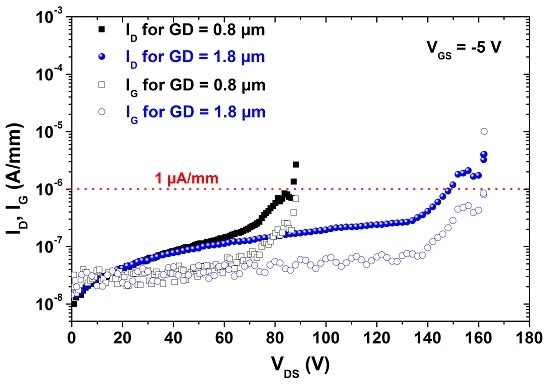High Electron Confinement under High Electric Field in RF GaN-on-Silicon HEMTs
Abstract
:1. Introduction
2. Experimental Section
3. Results and Discussion
3.1. DC Characteristics
3.2. RF Characteristics
4. Conclusions
Acknowledgments
Author Contributions
Conflicts of Interest
References
- Shinohara, K.; Regan, D.; Corrion, A.; Brown, D.; Burnham, S.; Willadsen, P.J.; Alvarado-Rodriguez, I.; Cunningham, M.; Butler, C.; Schmitz, A.; et al. Deeply-Scaled Self-Aligned-Gate GaN DH-HEMTs with Ultrahigh Cutoff Frequency. In Proceedings of the IEEE International Electron Devices Meeting (IEDM), Washington, DC, USA, 5–7 December 2011; Volume 19, pp. 1–4.
- Shinohara, K.; Regan, D.C.; Tang, Y.; Corrion, A.L.; Brown, D.F.; Wong, J.C.; Robinson, J.F.; Fung, H.H.; Schmitz, A.; Oh, T.C.; et al. Scaling of GaN HEMTs and Schottky Diodes for Submillimeter-Wave MMIC Applications. IEEE Trans. Electron Devices 2013, 60, 2982–2996. [Google Scholar] [CrossRef]
- Tirelli, S.; Marti, D.; Sun, H.; Alt, A.R.; Carlin, J.-F.; Grandjean, N.; Bolognesi, C.R. Fully Passivated AlInN/GaN HEMTs with fT/fMAX of 205/220 GHz. IEEE Electron Device Lett. 2011, 32, 1364–1366. [Google Scholar] [CrossRef]
- Yue, Y.; Hu, Z.; Guo, J.; Sensale-Rodriguez, B.; Li, G.; Wang, R.; Faria, F.; Song, B.; Gao, X.; Guo, S.; et al. Ultrascaled InAlN/GaN High Electron Mobility Transistors with Cutoff Frequency of 400 GHz. Jpn. J. Appl. Phys. 2013, 52, 08JN14. [Google Scholar] [CrossRef]
- Zimmermann, T.; Deen, D.; Cao, Y.; Simon, J.; Fay, P.; Jena, D.; Xing, H.G. AlN/GaN Insulated-Gate HEMTs with 2.3 A/mm Output Current and 480 mS/mm Transconductance. IEEE Electron Device Lett. 2008, 29, 661–664. [Google Scholar] [CrossRef]
- Meneghesso, G.; Meneghini, M.; Bisi, D.; Rossetto, I.; Wu, T.; van Hove, M.; Marcon, D.; Stoffels, S.; Decoutere, S.; Zanoni, E. Trapping and reliability issues in GaN-based MIS HEMTs with partially recessed gate. Microelectron. Reliab. 2015, in press. [Google Scholar] [CrossRef]
- Medjdoub, F.; Zegaoui, M.; Rolland, N.; Rolland, P.A. Demonstration of low leakage current and high polarization in ultrathin AlN/GaN high electron mobility transistors grown on silicon substrate. Appl. Phys. Lett. 2011, 98, 223502. [Google Scholar] [CrossRef]
- Cheng, K.; Degroote, S.; Leys, M.; Medjdoub, F.; Derluyn, J.; Sijmus, B.; Germain, M.; Borghs, G. AlN/GaN heterostructures grown by metal organic vapor phase epitaxy with in situ Si3N4 passivation. J. Crystal Growth 2011, 315, 204–207. [Google Scholar] [CrossRef]
- Medjdoub, F.; Grimbert, B.; Ducatteau, D.; Rolland, N. Record combination of power-gain cut-off frequency and three-terminal breakdown voltage for GaN-on-silicon devices. Appl. Phys. Express 2013, 6, 044001. [Google Scholar] [CrossRef]
- Medjdoub, F.; Zegaoui, M.; Grimbert, B.; Rolland, N.; Rolland, P.A. Effects of AlGaN Back Barrier on AlN/GaN-on-Silicon High-Electron-Mobility Transistors. Appl. Phys. Express 2011, 4, 124101. [Google Scholar] [CrossRef]
- Medjdoub, F.; Zegaoui, M.; Waldhoff, N.; Grimbert, B.; Rolland, N.; Rolland, P.A. Above 600 mS/mm transconductance with 2.3 A/mm drain current density AlN/GaN high-electron-mobility transistors grown on silicon. Appl. Phys. Express 2011, 4, 064106. [Google Scholar] [CrossRef]
- Derluyn, J.; Boeykens, S.; Cheng, K.; Vandersmissen, R.; Das, J.; Ruythooren, W.; Degroote, S.; Leys, M.R.; Germain, M.; Borghs, G. Improvement of AlGaN/GaN high electron mobility transistor structures by in situ deposition of a Si3N4 surface layer. Appl. Phys. Lett. 2005, 98, 054501. [Google Scholar]
- Murase, Y.; Asano, K.; Takenaka, I.; Ando, Y.; Takahashi, H.; Sasaoka, C. T-Shaped Gate GaN HFETs on Si with Improved Breakdown Voltage and fMAX. IEEE Electron Device Lett. 2014, 35, 524–526. [Google Scholar] [CrossRef]
- Hoshi, S.; Itoh, M.; Marui, T.; Okita, H.; Morino, Y.; Tamai, I.; Toda, F.; Seki, S.; Egawa, T. 12.88W/mm GaN High Electron Mobility Transistor on Silicon Substrate for High Voltage Operation. Appl. Phys. Express 2009, 2, 061001. [Google Scholar] [CrossRef]




© 2016 by the authors; licensee MDPI, Basel, Switzerland. This article is an open access article distributed under the terms and conditions of the Creative Commons by Attribution (CC-BY) license (http://creativecommons.org/licenses/by/4.0/).
Share and Cite
Medjdoub, F.; Kabouche, R.; Dogmus, E.; Linge, A.; Zegaoui, M. High Electron Confinement under High Electric Field in RF GaN-on-Silicon HEMTs. Electronics 2016, 5, 12. https://doi.org/10.3390/electronics5010012
Medjdoub F, Kabouche R, Dogmus E, Linge A, Zegaoui M. High Electron Confinement under High Electric Field in RF GaN-on-Silicon HEMTs. Electronics. 2016; 5(1):12. https://doi.org/10.3390/electronics5010012
Chicago/Turabian StyleMedjdoub, Farid, Riad Kabouche, Ezgi Dogmus, Astrid Linge, and Malek Zegaoui. 2016. "High Electron Confinement under High Electric Field in RF GaN-on-Silicon HEMTs" Electronics 5, no. 1: 12. https://doi.org/10.3390/electronics5010012






